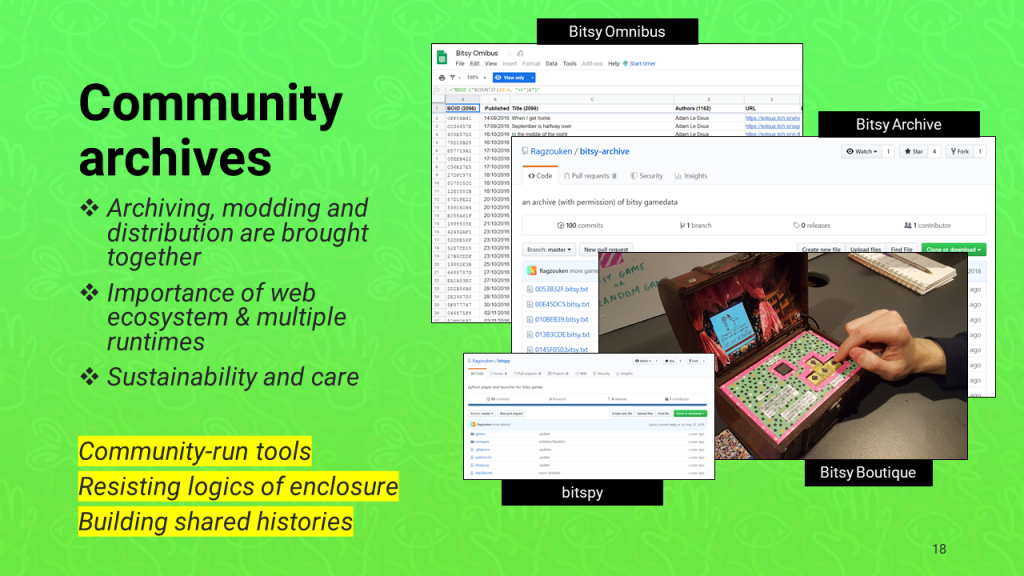I presented a talk on game making tools as sharing practices as part of the Sharing Games: Proliferation, Posterity, Practice panel of the CGSA 2019 conference.
Here is the description of the presentation and some of its slides.
Game making is a loosely connected set of situated practices which involve a diverse, entangled arrangement of materials, knowledges, and repertoires. The notion of industrial pipelines for digital game making is inadequate to describe this diversity. Different communities create tools and processes and then circulate and appropriate them in ways that combine play, work, and creation beyond professionalized, commercial development. The design of such tools both supports and is shaped by the practices around them. Examining this relationship is a messy affair, but is key to positioning such practices: questions of gatekeeping, political positioning, and critical literacy are intertwined with how such tools and practices materialize and present game making.
In my presentation, I will look at different digital game making tools in terms of their game formats, arrangements of use and circulation, and how they support hybridity of hardware / middleware / software. What roles do these features play in circulating diverse visions of game making? My case studies range from fantasy consoles (PICO-8), to free and open-source standalone game engines (Superpowers, Duality), web-based tools (Bitsy), smartphone game making tools (Flatpack), and in-game editors in commercial consoles (Nintendo’s Toy-Con garage). The focus of analysis is not on the game design features of games created with such tools, but on the usually hidden and assumed overall systems of objects and interpersonal relationships (Burckhardt, 2012, p.165) around them. Throughout this close analysis, I examine tension lines and highlight intersections for critical design interventions and an active engagement with how game making circulates.
Works cited
Boluk, S., & LeMieux, P. (2017). Metagaming: Playing, Competing, Spectating, Cheating, Trading, Making, and Breaking Videogames. Minnesota, UNITED STATES: University of Minnesota Press. Retrieved from http://ebookcentral.proquest.com/lib/concordia-ebooks/detail.action?docID=4745543
Buechley, L., Rosner, D. K., Paulos, E., & Williams, A. (2009). DIY for CHI: Methods, Communities, and Values of Reuse and Customization. In CHI ’09 Extended Abstracts on Human Factors in Computing Systems (pp. 4823–4826). New York, NY, USA: ACM. https://doi.org/10.1145/1520340.1520750
Burckhardt, L. (2012). Design is Invisible in Lucius Burckhardt Writings: Rethinking Man-made Environments: Politics, Landscapes & Design. (J. Fezer & M. Schmitz, Eds.). New York: SpringerWienNewYork.
Galloway, A., Brucker-Cohen, J., Gaye, L., Goodman, E., & Hill, D. (2004). Design for Hackability. In Proceedings of the 5th Conference on Designing Interactive Systems: Processes, Practices, Methods, and Techniques (pp. 363–366). New York, NY, USA: ACM. https://doi.org/10.1145/1013115.1013181
Harvey, A. (2014). Democratization, depoliticization, and the queering of game design. GAME – The Italian Journal of Game Studies, 1(03), 13.
Freedman, E. (2018). Engineering Queerness in the Game Development Pipeline. Game Studies, 18(3). Retrieved from http://gamestudies.org/1803/articles/ericfreedman.



